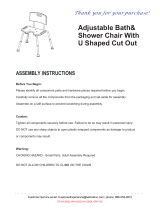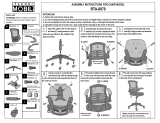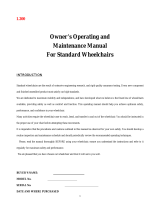P.26P.25
IV. WARRANTY
A) WARRANTY CONDITIONS
Congratulations on your choice of the Rupiani WEELY Comfort Wheelchair.
Rupiani assures that the mechanical components of this product when purchased
new and unused to be free from defects in materials and workmanship within the
quality guarantee period date of purchase from Rupiani or a dealer, with a copy of the
seller’s invoice required for coverage under this warranty.
- The quality guarantee period for the FRAME : 2 Years
- The quality guarantee period for the components: 1 Year
(Components excluding easy-worn-out components)
The foregoing warranty shall not apply to:
- Products damaged by reason of repairs made to any component without the spe-
cic consent of Rupiani or to a product damaged by circumstances beyond Rupiani’s
control, and such evaluation will be solely determined by Rupiani
- Normal wear and tear or failure to adhere to the product instructions
- The product if it is improperly set up
- Serial numbered products if the serial number has been removed or defaced
Rupiani declines any responsibility for damages caused by negligence, accident, im-
proper operation, maintenance or storage products modied or opened without Ru-
piani expressed written consent (including, but not limited to modication through
the use of unauthorized parts or attachments).
The foregoing expressed warranty is exclusive and in lieu of any other warranties
whatsoever, whether expressed or implied, including the implied warranties of mer-
chantability and tness for a particular purpose, shall be limited to repair or replace-
ment of the defective product pursuant to the terms contained herein.
The application of any implied warranty shall not extend beyond the duration of the
express warranty provided herein.
Rupiani shall not be liable for any consequential or incidental damages, or any dis-
crepancy of the products shipped due to cause for which the insurance company,
carrier, shipping company, other transportation organization and /or post oce are
liable.
3. VEHICLE
1) Position wheelchair as close as possible to the desired vehicle seat
2) Engage wheel locks
3) Raise up the armrest nearest to the vehicle
4) Pivot footplates and leg rests upwards to vertical position
5) Shift body weight into seat by placing one hand that is closest to the vehicle on
top of the seat upholstery with another arm poised on the armrest
6) Securely position yourself in the vehicle seat and fasten the seat belt
STORING THE WHEELCHAIR FOR TRANSPORTATION :
Remove the following components:
1. Backrest
2. Headrest
3. Armrests
4. Cushions of the seat and backrests
5. Legrests
a b c
CAUTION
DO NOT sit on the wheelchair when in a vehicle





















